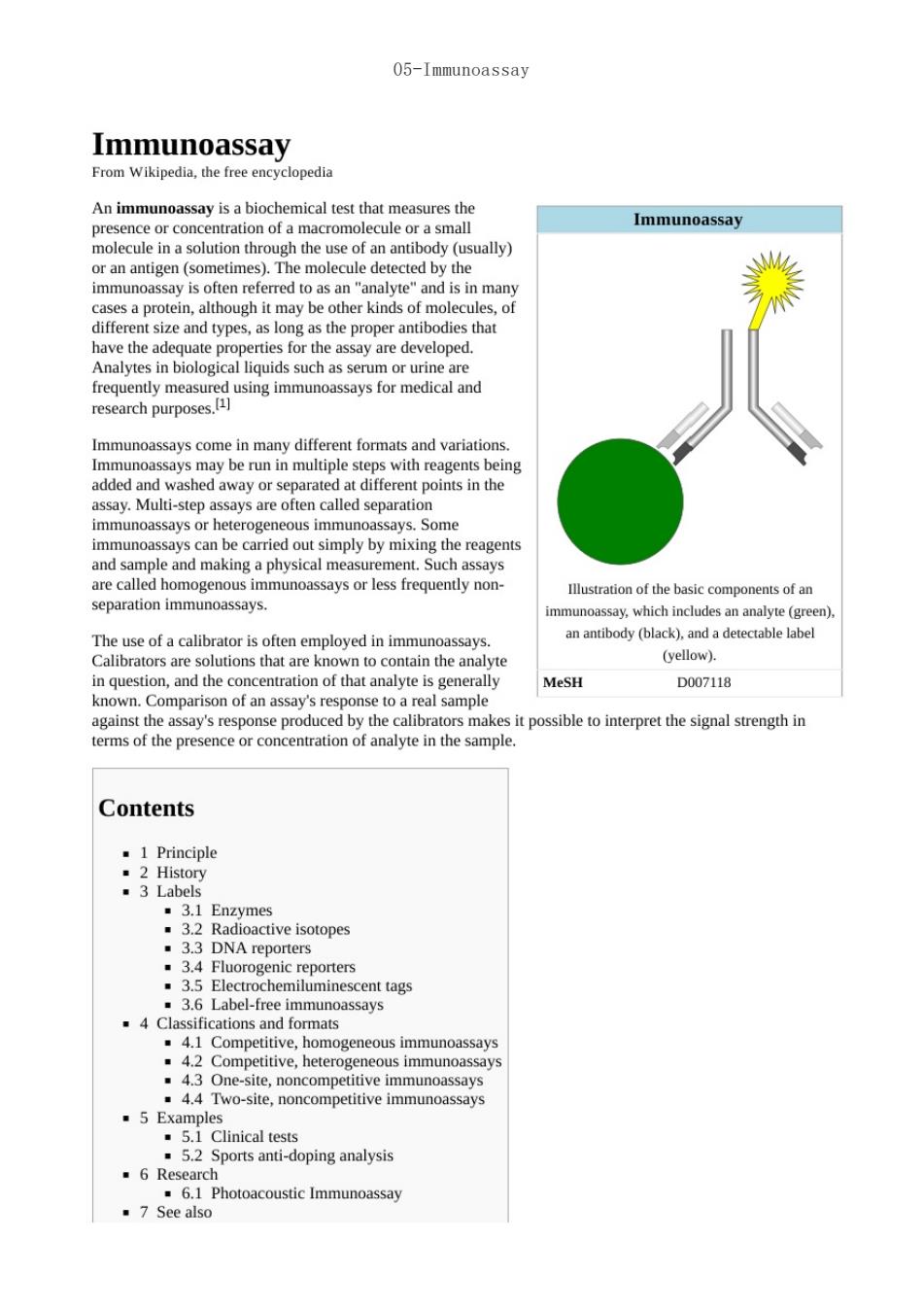
05-Immunoassay Immunoassay From Wikipedi the free encyclopedi An immunassay isa biochemical test that measures the Immunoassay (ally) or an antigen (sometimes)The molecule detected by the immunoassay is often referred to as an "analyte"and is in many cases a protein have the ade Analytes in biological liquids such as serum or urineare freqinay for mdicaland research purposes Immunoassays come in many different formats and variations. d away or separate points in the immunoassays can be carried out simply by mixing the reagents and sample and making a physical measurement.Such assays are call less frequently non Illustration of the basic components of an sepa immunoassay,which includes an analyte (green) The use of a caibr often employed in immunoassays an antibody (black).and a detectable label (yellow). and the of tha ate is MeSH D007118 known.Comparison of an assay's response to a real sample against the assay's response produced by the calibrators makes it possible to interpret the signal strength in terms of the presence or concentration of analyte in the sample Contents ·1 Principle 3 Labels ·3.1 Enzymes ctive isotopes enic reporters miluminescent tags ssays .4 Classifications and formats 5 Exampless,noncompetvey .5.2 Sports anti-doping analysis ·6 7 See also Photoacoustic Immunoassay
05-Immunoassay
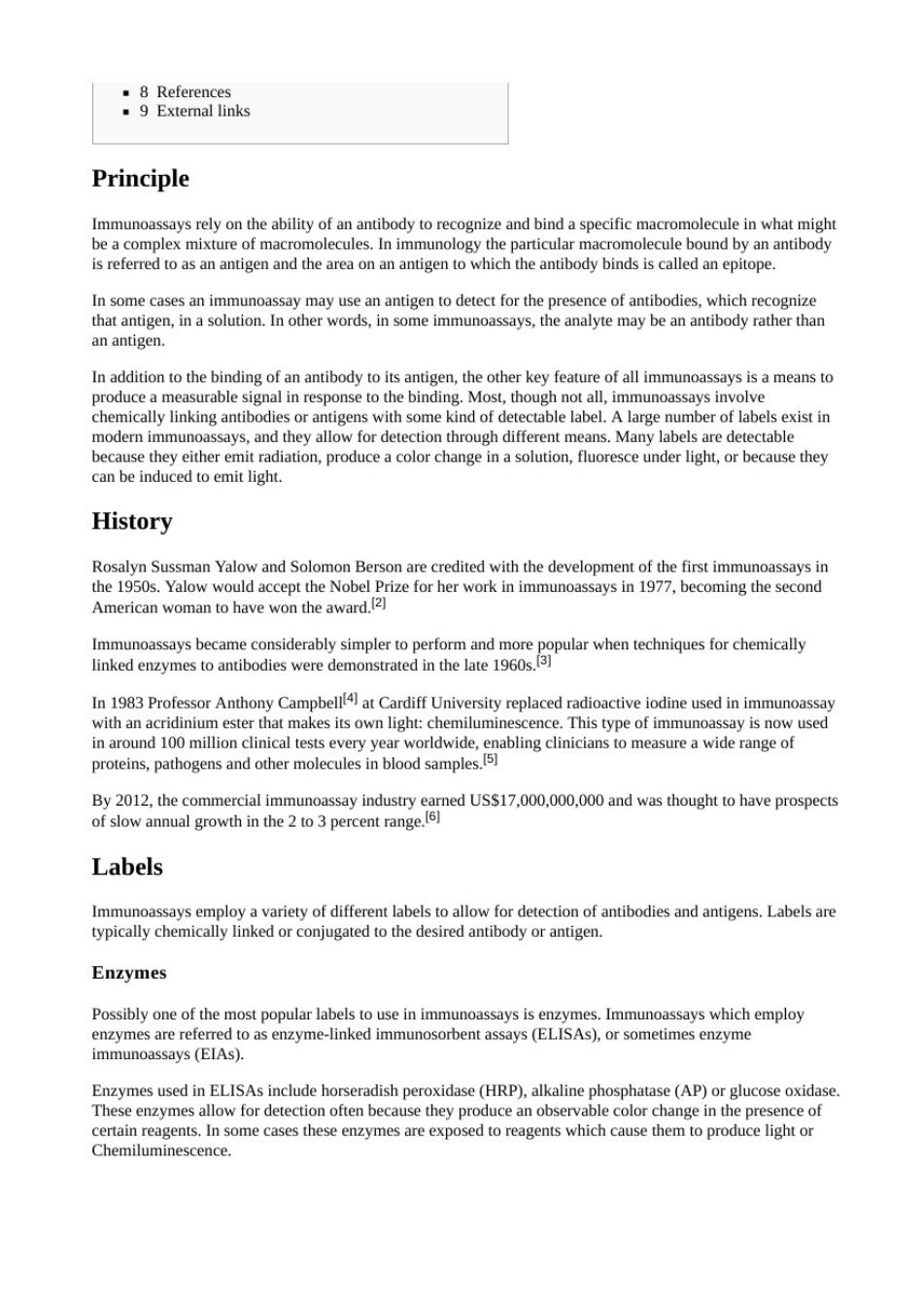
8 References .9 External links Principle Immunoassays rely on the ability of an antibody to recognize and bind a specific macromolecule in what might be a complex mixture of macromolecules.In immunology the particular macromolecule bound by an antibody is referred to as an antigen and the area on an antigen to which the antibody binds is called an epitope. In some cases an immunoassa y may use an antigen to detect for the presence of antibodies,which recognize that antigen,in a solution.In other words,in some immunoassays,the analyte may be an antibody rather than an antigen aothe binding of an antibody tosnin the other key featre of al mmnssays isa mean ea m signal in response to modern imp because they either emit radiation,produce a color change in a solution,fluoresce under light,or because they can be induced to emit light. History Rosalyn Sussman Yalow and Solomon Berson are credited with the development of the first immunoassays in the 1950s.Yalow v merican woman to have won the wde for her work in immunoassays n 1 becoming the second d accept the Nob r e红c In 1983 Professor Anthony Campbell4]at Cardiff University replaced radioactive iodine used in immunoassay with an acridinium ester that makes its own light:chemiluminescence.This type of immunoassay is now used proteins,pathogens and other molecules in blood samples 2203筒mdUS5s17ono0wao咖pop Labels Immunoassays employ a variety of different labels to allow for detection of antibodies and antigens.Labels are typically chemically linked or conjugated to the desired antibody or antigen. Enzymes Possibly one of the most popular labels to use in immunoassays is er mes.Immunoassays which employ enzymes are referred to as enzyme-linked immunosorbent assays(ELISAs),or sometimes enzyme immunoassays (EIAs). Enzymes used in ELISAs include horseradish peroxidase(HRP),alkaline phosphatase(AP)or glucose oxidase These enzymes allow for detection often because they produce an observable color change in the presence of reagents.n some cases these enzymes are exposed to reagents which cause them to produce light or
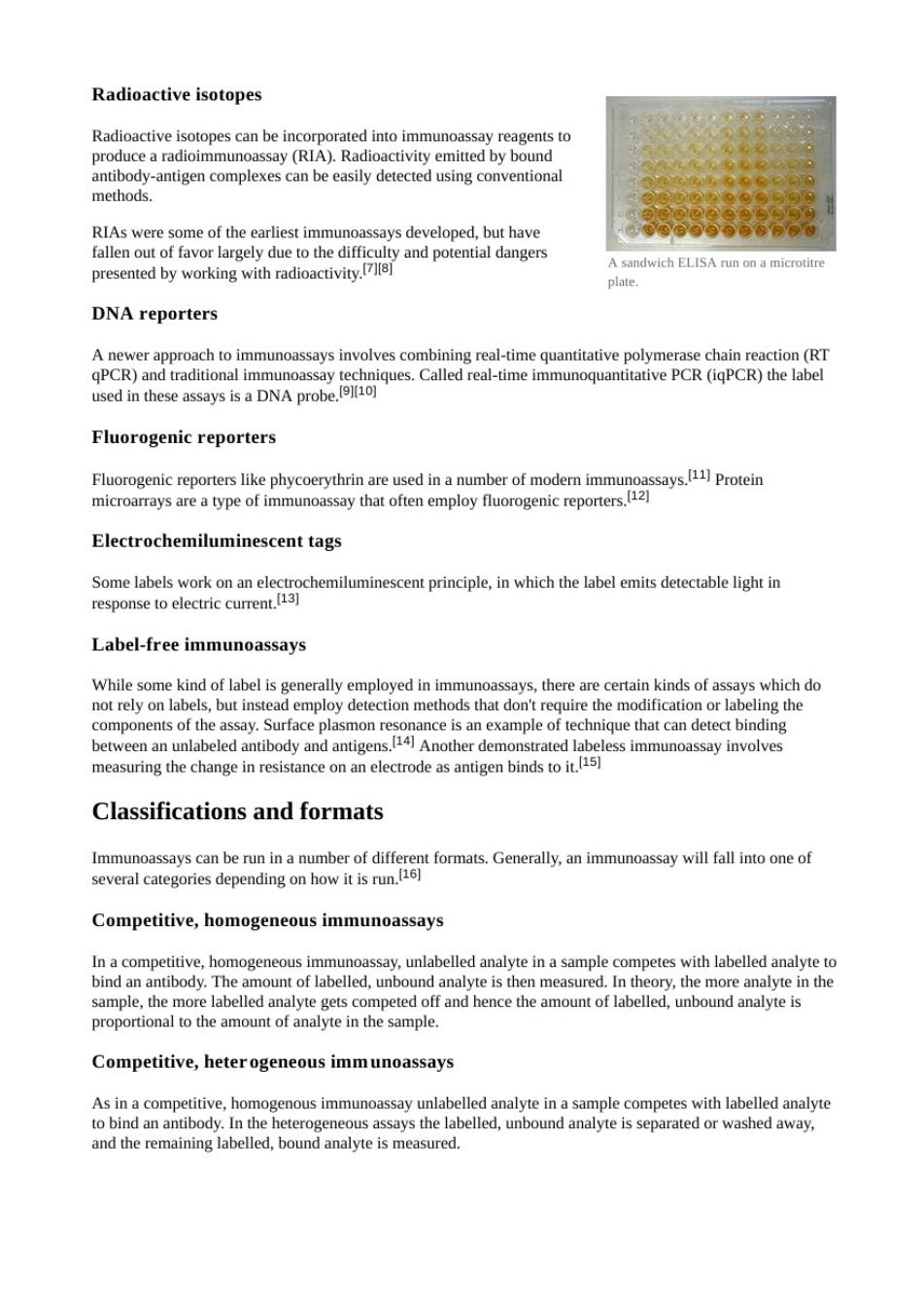
Radioactive isotopes Radioactive isotopes can be incorporated into immunoassay reagents to produce a radioimmunoassay (RIA).Radioactivity emitted by bound okamoapaseatea7tandsngomao RIAs were some of the earliest immunoassays developed,but have fallen out of fav wich ELISA run on a microtit DNA reporters A newer approach to immunoassays involves combining real-time quantitative polymerase chain reaction(RT PCR)rea-imemmiiv PCR(CR)the label used in these assays is a DNA probe Fluorogenic reporters micarayar ofthat ofen mloy ugnic Fluorogenic reporters like phycoerythrin are used in a number of modern immun Electrochemiluminescent tags onse to electric cu an el Label-free immunoassays not rely on it do s of th eis an that can detect bindin between an unlabeled antibody and antigen measuring the change in resistance on an electrode as antigen binds to it. Classifications and formats Competitive,homogeneous immunoassays mogeneous d competes sample.the more labelled analyte gets competed off and hence the amount of labelled.unbound analyte is proportional to the amount of analyte in the sample. Competitive,heterogeneous immunoassays As in a competitive.ho os immunoassay unlabelled analyte in a sample co and the remaining labelled,bound analyte is measured
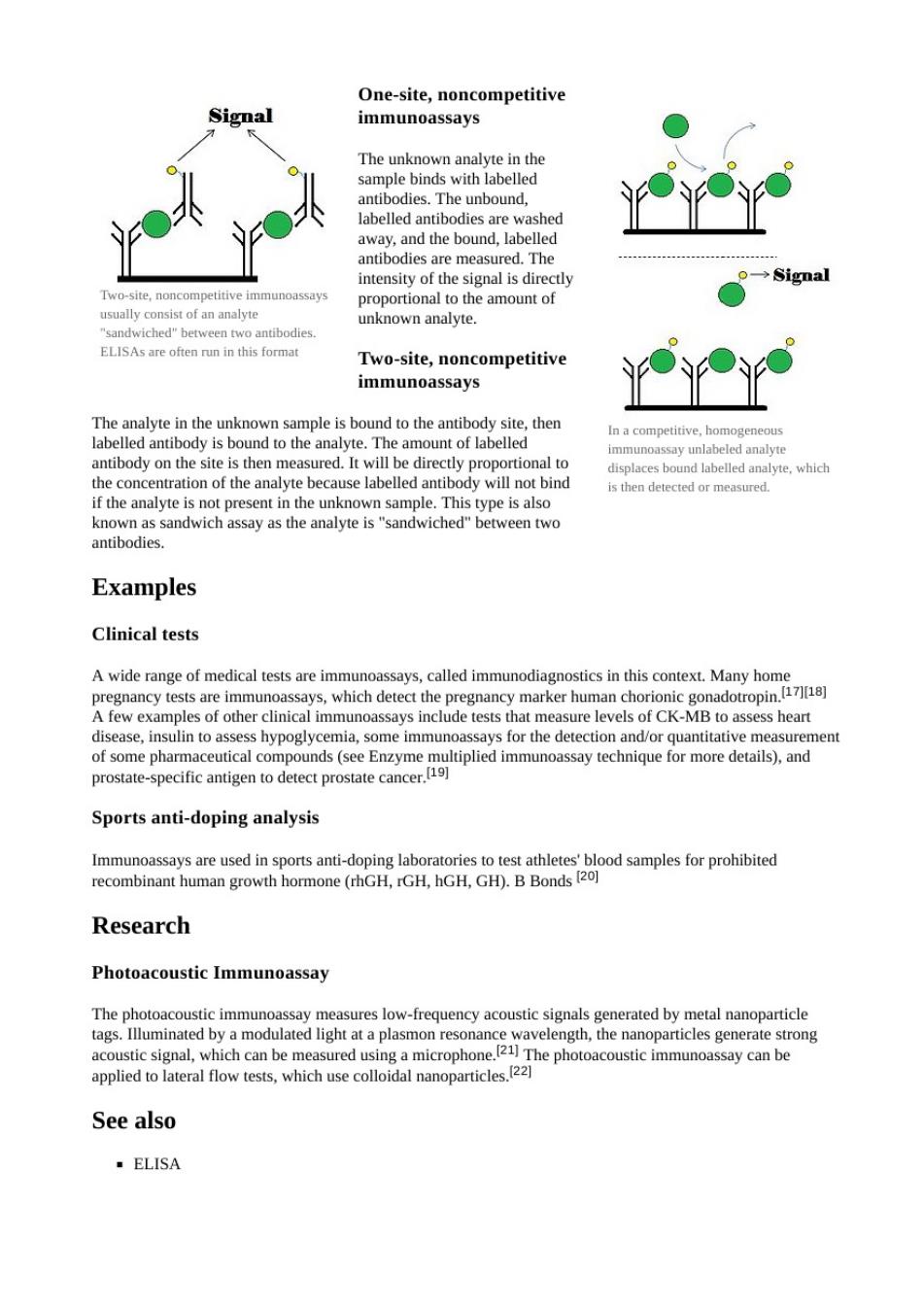
One-site,noncompetitive Signal immunoassays The unknown analyte in the sample binds with labelled d.The unbound es art antibodies are measured.The intensity of the signal is directly sist of an analyte 【to the amount of known analyte Two-site,noncompetitive immunoassays The analyte in the unknown sample is bound to the antibody site,then labelled anti ody is bound to the analyte.The amount of labelled dy on th ly prop displaces b und labelled a lyte.which pe is also is then detected or measured if the analyte is not present in the unknown sample.This ty known as sandwich assay as the analyte is"sandwiched"between two antibodies. Examples Clinical tests wierae ofmediaaremmyallmhiscMmy s are cliniays,which disease.insulin to assess hyr mia some immunoa ays for the detection and/or quantitative measur emen 2a时 Sports anti-doping analysis e used in s orts anti-dopi Research Photoacoustic Immunoassay The photoacoustic immunoassay measures low-frequency acoustic signals generated by metal nanoparticle tags.Illuminated by a modulated light at a plasmon resonan dcoustic signal.which can be measured usingmiavelength.the nanoparticles generate strong toteraowtests.which use olssay can See also ·ELISA
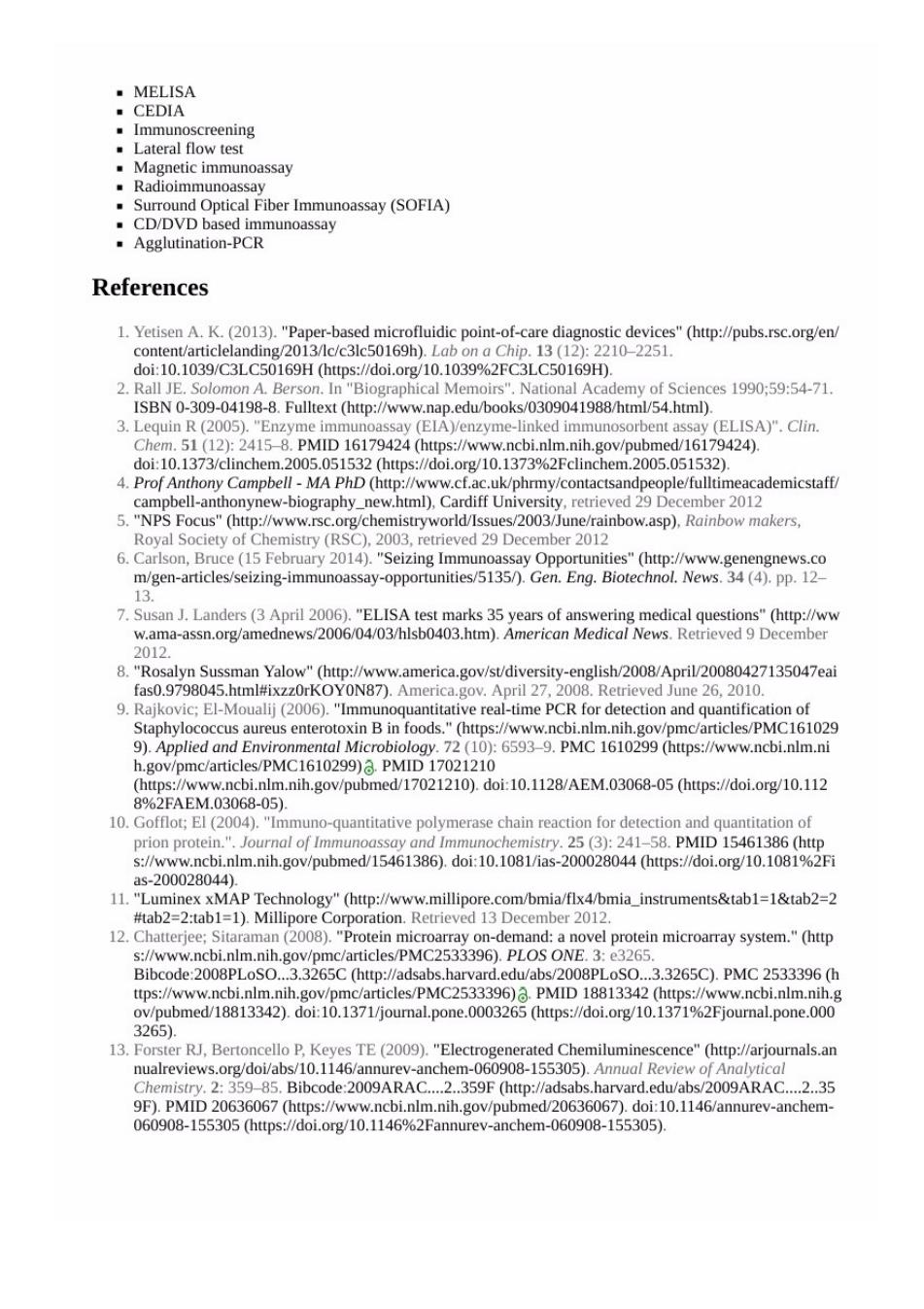
·MELISA ·CEDIA Magnetic immunoassay noassay(SOFIA) 。Agglutination-PCR References 001039C3LC50169H s://doi /10.10399%2FC3LC50169 y of Sciences 1990:59:54-71. Fulltext (http://www /b 41988html/5 .htmi). (ELISA)".Clin Chem.51(12):2415-8.PMID16179424(https://www.ncbi.nlm.nih.gov/pubmed/16179424). https://doi.org/10.1373%2Fclinchem 2005.051532) campbel-anthonynew-bio hy r new.humD).Cardiff Univ 'NPS Focus"(http://www.rsc rg/chemistryworld/Issues/2003/June/rainbow.asp).Rainbow makers. e15Feh 2014)."Seizing I ber ews.co m/gen-articles/seizing-immunoassay-opportnities/5135)Gen.Eng.Biorechnol.News.()pp.1 san I Landers (3 April 2006 "(http://w w.ama-assn.org/amednews/2006/04/03/hlsb0403.htm).Americon Medical News.Retrieved 9 December 26.2010 9.R El-Moualij (20 "Immunoquantitative real-time PCR for detection and quantific n o I Mi 065939.PMC1610299 h.gov/pmc/articles/PMC1610299)PMID 10.Gofflot:El (2004)."mmuno-quantitative polymerase chain reaction for detection and quantitation of prion protei al of Ir uminex xMAP T chnology"(http://www.millipore.com/bmia/flx4/bmia_instruments&tab1=1&tab2=2 12C22 -1).M 08)oratio s://www.ncbi.nlm.nih.g omc/articles/PMC2533396).PLOS ONE.3: system.(hup Bibcode:2008PI .3265C).PMC2533396 01 -060908-155305 :/arjourals.an .235 5Bibcode:2009ARAC0636061011460AR
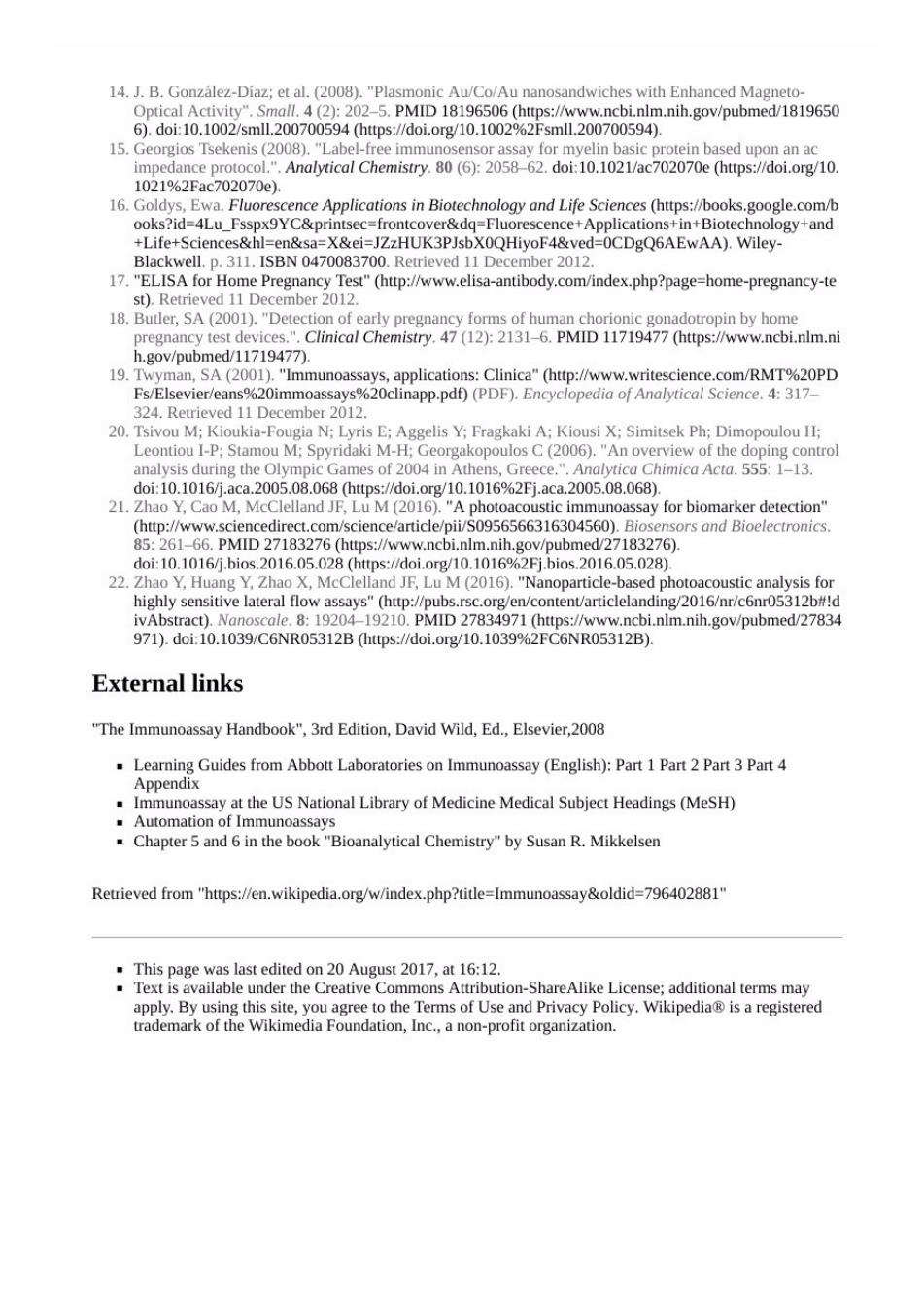
14.J.B.Gonzalez-Diaz:et al.(2008)."Plasmonic Au/Co/Au nanosandwiches with Enhanced Magneto 000 gov/pubmed119650 gios Tsekenis (2008)."Labe org/1 fo otein hased u c70 70e ooks?id-4Lu_Fsspx9YC&prir &printsec=frontcover&dg=Fytand ed=0CDgQ6AEWAA).Wiley- 17."ELISA for Home Pres nancy Test"(http:/www.elisa-antibody.com/index.php?page=home-pregnancy-te mber 2012 18. el, h.gov/pubmed/11719477). SA (220ir pp.p 324.Retrieved 11 December 2012. 20. Tsivou M:Kioukia-Fo 8els Fragkaki A Simitsek Ph: mopoulou H: nalysis during the ic Games of 2004 in Athens,Greece.Chimica Act.. 2 2i0101ca2050e B.068 (https://doi.org/10.1016%2Fj.aca.20 005.08.068) 6.PMID 27183276(hps://www.ncbi.nlm.nih.gov/pubmed/27183276) 6 highly sensitive lateral flow assays"(http:/pubs.rsc.org/en/content/articlelanding/2016/nr/ .nlm.nih.gov/pubmed/27834 External links "The Immunoassay Handbook",3rd Edition,David Wild,Ed.Elsevier,2008 .Learning Guides from Abbott Laboratories on Immunoassay(English):Part 1 Part 2 Part 3 Part 4 Immunoassay at the US National Library of Medicine Medical Subject Headings (MeSH) Retrieved from"https://en.wikipedia.org/w/index.php?tite=mmunoassay&oldid=796402881 .This page was last edited on 20 August 2017.at 16:12. ·Text is available